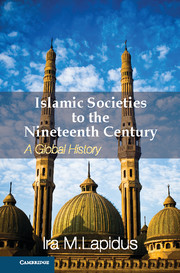Book contents
- Frontmatter
- Contents
- List of Illustrations
- List of Figures
- List of Maps
- List of Tables
- Preface
- Acknowledgments
- Acknowledgments to the first edition of A History of Islamic Societies
- Acknowledgments to the second edition of A History of Islamic Societies
- Publisher's Preface
- Introduction to Islamic Societies
- Part I The Beginnings of Islamic Civilizations
- Part II From Islamic Community to Islamic Society
- Part III The Global Expansion of Islam from the Seventh to the Nineteenth Centuries
- Chapter 25 Introduction: Islamic Institutions
- The Western Islamic Societies
- Islam in Asia
- Chapter 30 Introduction: Empires and Societies
- Chapter 31 The Turkish Migrations and the Ottoman Empire
- Chapter 32 The Postclassical Ottoman Empire: Decentralization, Commercialization, and Incorporation
- Chapter 33 The Arab Provinces Under Ottoman Rule
- Chapter 34 The Safavid Empire
- Chapter 35 The Indian Subcontinent: The Delhi Sultanates and the Mughal Empire
- Chapter 36 Islamic Empires Compared
- Chapter 37 Inner Asia From the Mongol Conquests to the Nineteenth Century
- Chapter 38 Islamic Societies in Southeast Asia
- Islam in Africa
- Conclusion
- Glossary
- Bibliography
- Annotated Bibliography from A History of Islamic Societies, 2nd Edition
- Index
Chapter 37 - Inner Asia From the Mongol Conquests to the Nineteenth Century
Published online by Cambridge University Press: 05 February 2013
- Frontmatter
- Contents
- List of Illustrations
- List of Figures
- List of Maps
- List of Tables
- Preface
- Acknowledgments
- Acknowledgments to the first edition of A History of Islamic Societies
- Acknowledgments to the second edition of A History of Islamic Societies
- Publisher's Preface
- Introduction to Islamic Societies
- Part I The Beginnings of Islamic Civilizations
- Part II From Islamic Community to Islamic Society
- Part III The Global Expansion of Islam from the Seventh to the Nineteenth Centuries
- Chapter 25 Introduction: Islamic Institutions
- The Western Islamic Societies
- Islam in Asia
- Chapter 30 Introduction: Empires and Societies
- Chapter 31 The Turkish Migrations and the Ottoman Empire
- Chapter 32 The Postclassical Ottoman Empire: Decentralization, Commercialization, and Incorporation
- Chapter 33 The Arab Provinces Under Ottoman Rule
- Chapter 34 The Safavid Empire
- Chapter 35 The Indian Subcontinent: The Delhi Sultanates and the Mughal Empire
- Chapter 36 Islamic Empires Compared
- Chapter 37 Inner Asia From the Mongol Conquests to the Nineteenth Century
- Chapter 38 Islamic Societies in Southeast Asia
- Islam in Africa
- Conclusion
- Glossary
- Bibliography
- Annotated Bibliography from A History of Islamic Societies, 2nd Edition
- Index
Summary
For millennia, the central theme in the history of the vast and varied regions that lie between the settled parts of the Middle East and of China was the relationship between nomadic-pastoral and sedentary peoples. Whereas the great civilizations of the Middle East and China were primarily imperial and agricultural, the region between them was a zone of steppe lands and scattered oases. The population was predominantly pastoral and lived by raising horses and sheep. It was also organized into clans and tribes, which were sometimes assembled into great confederations. The settled peoples lived primarily in the oasis districts of Transoxania, Khwarizm, Farghana, and Kashgar, and in scattered towns along the trade routes that linked China, the Middle East, and Europe. Settled and pastoral peoples had close relationships with one another, exchanging products and participating in caravan trade. Pastoral peoples also infiltrated the settled areas and became farmers or townsmen. Sometimes they conquered the agricultural oases and became rulers and landlords. Inner Asia was also the reservoir holding a sea of peoples who, organized into great confederations, from time to time conquered the Middle East and China. From the second millennium BCE to the eighteenth century, the history of the region may be told in terms of ever-repeated nomadic conquests, the formation of empires over oasis and settled populations, and the constant tension between pastoral and agricultural peoples.
The development of an Islamic civilization in Inner Asia was closely related to that of Iran. Islam first spread in this region as a result of the Arab conquests of Iran and Transoxania and the movement of Muslim traders and Sufis from the towns to the steppes. The two regions were also linked by the Turkish migrations of the tenth to the fourteenth centuries that brought Inner Asian peoples into Iran, and Iranian monarchical culture and Islamic civilization into Inner Asia. In the tenth and eleventh centuries, Qarluq and Oghuz peoples converted and founded the Qarakhanid and Saljuq empires. Under the Qarakhanids, the Hanafi school of law and Maturidi school of theology were established in Transoxania, and a new Turkish literature inspired by Persian Islamic literature came into being. The Qarakhanids also favored the diffusion of Islam from Transoxania into the Tarim basin and the northern steppes. Sufi preachers, especially Shaykh Ahmad al-Yasavi (d. 1166), helped to spread Islam among nomadic peoples.
- Type
- Chapter
- Information
- Islamic Societies to the Nineteenth CenturyA Global History, pp. 543 - 560Publisher: Cambridge University PressPrint publication year: 2012



